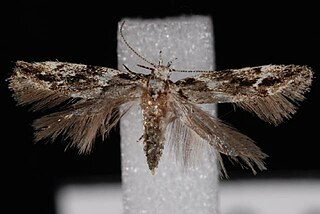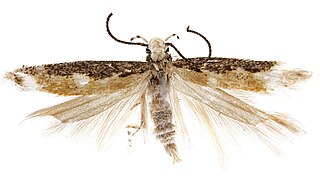
The Gelechiidae are a family of moths commonly referred to as twirler moths or gelechiid moths. They are the namesake family of the huge and little-studied superfamily Gelechioidea, and the family's taxonomy has been subject to considerable dispute. These are generally very small moths with narrow, fringed wings. The larvae of most species feed internally on various parts of their host plants, sometimes causing galls. Douglas-fir (Pseudotsuga) is a host plant common to many species of the family, particularly of the genus Chionodes, which as a result is more diverse in North America than usual for Gelechioidea.

Phthorimaea operculella, also known as the potato tuber moth or tobacco splitworm, is a moth of the family Gelechiidae. It is an oligophagous insect that feeds on the plant family Solanaceae and is especially known for being a major pest of potato crops. Currently farmers utilize insecticides, parasites, and sprinkler irrigation in order to prevent P. operculella from infesting their croplands.

Megacraspedus is a genus of moths in the family Gelechiidae, found primarily in the Palearctic.

Monochroa is a genus of moths in the family Gelechiidae.
Schizovalva is a genus of moths in the family Gelechiidae.

Recurvaria leucatella is a moth of the family Gelechiidae. It is found in most of Europe, Turkey, Central Asia and the Caucasus.

The Angoumois grain moth is a species of the Gelechiidae moth family, commonly referred to as the "rice grain moth". It is most abundant in the temperate or tropical climates of India, China, South Africa, Indonesia, Malaysia, Japan, Egypt and Nigeria, with its location of origin being currently unknown. It is most commonly associated as a pest of field and stored cereal grains as they burrow within the kernel grains of crop plants, rendering them unusable for human consumption. By laying eggs between the grains themselves and hatching at a later time, often during the processing, transportation or storage stages, the moth can be transported to households or countries presently free of Angoumois grain moth infestations. Thus, constant protection against the Angoumois grain moth is required for grain up till the time of consumption.

Dichomeridinae is a subfamily of moths in the family Gelechiidae.

Chionodes distinctella, the eastern groundling, is a moth of the family Gelechiidae. It is found in almost all of Europe, as well as most of Russia, Kazakhstan, Central Asia and North Africa. The habitat consists of dry, rocky heath and meadows and the verges and rough pastures.

Recurvaria nanella, the lesser bud moth, is a moth of the family Gelechiidae. It is widely distributed in Europe and is also found in Turkey, the Near East, North Africa, the Caucasus, Transcaucasia, Kazakhstan and south-eastern Siberia. It is also found in North America, where it is probably introduced.

Gelechiinae is a subfamily of moths in the family Gelechiidae. It was described by Henry Tibbats Stainton in 1854.

Thiotrichinae is a subfamily of moths in the family Gelechiidae.
Armatophallus is a genus of moths in the family Gelechiidae.
Armatophallus kuehnei is a moth of the family Gelechiidae. It is found in Rwanda.
Armatophallus akagericus is a moth of the family Gelechiidae. It is found in Rwanda.
Armatophallus hackeri is a moth of the family Gelechiidae. It is found in Yemen and Ethiopia.
Armatophallus indicus is a moth of the family Gelechiidae. It is found in India (Rajasthan).

Neopalpa donaldtrumpi is a moth species of the genus Neopalpa occurring in Southern California and Northern Mexico. It was described in 2017 by Iranian-Canadian scientist Vazrick Nazari. Known for its yellowish-white head scales being reminiscent of Donald Trump's hair, the moth was given its name because Nazari stated that he wanted "to bring wider public attention to the need to continue protecting fragile habitats in the US that still contain many undescribed species."
Ronald William Hodges, known as Ron, was an American entomologist and lepidopterist.









